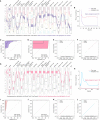Ensemble deep learning enhanced with self-attention for predicting immunotherapeutic responses to cancers
- PMID: 36532083
- PMCID: PMC9751999
- DOI: 10.3389/fimmu.2022.1025330
Ensemble deep learning enhanced with self-attention for predicting immunotherapeutic responses to cancers
Abstract
Introduction: Despite the many benefits immunotherapy has brought to patients with different cancers, its clinical applications and improvements are still hindered by drug resistance. Fostering a reliable approach to identifying sufferers who are sensitive to certain immunotherapeutic agents is of great clinical relevance.
Methods: We propose an ELISE (Ensemble Learning for Immunotherapeutic Response Evaluation) pipeline to generate a robust and highly accurate approach to predicting individual responses to immunotherapies. ELISE employed iterative univariable logistic regression to select genetic features of patients, using Monte Carlo Tree Search (MCTS) to tune hyperparameters. In each trial, ELISE selected multiple models for integration based on add or concatenate stacking strategies, including deep neural network, automatic feature interaction learning via self-attentive neural networks, deep factorization machine, compressed interaction network, and linear neural network, then adopted the best trial to generate a final approach. SHapley Additive exPlanations (SHAP) algorithm was applied to interpret ELISE, which was then validated in an independent test set.
Result: Regarding prediction of responses to atezolizumab within esophageal adenocarcinoma (EAC) patients, ELISE demonstrated a superior accuracy (Area Under Curve [AUC] = 100.00%). AC005786.3 (Mean [|SHAP value|] = 0.0097) was distinguished as the most valuable contributor to ELISE output, followed by SNORD3D (0.0092), RN7SKP72 (0.0081), EREG (0.0069), IGHV4-80 (0.0063), and MIR4526 (0.0063). Mechanistically, immunoglobulin complex, immunoglobulin production, adaptive immune response, antigen binding and others, were downregulated in ELISE-neg EAC subtypes and resulted in unfavorable responses. More encouragingly, ELISE could be extended to accurately estimate the responsiveness of various immunotherapeutic agents against other cancers, including PD1/PD-L1 suppressor against metastatic urothelial cancer (AUC = 88.86%), and MAGE-A3 immunotherapy against metastatic melanoma (AUC = 100.00%).
Discussion: This study presented deep insights into integrating ensemble deep learning with self-attention as a mechanism for predicting immunotherapy responses to human cancers, highlighting ELISE as a potential tool to generate reliable approaches to individualized treatment.
Keywords: ELISE; PD1/PD-L1; cancer; deep learning; immunotherapy.
Copyright © 2022 Jin, Yang, Chi, Wei, Zhang, Zhao, Chen, Xia and Li.
Conflict of interest statement
The authors declare that the research was conducted in the absence of any commercial or financial relationships that could be construed as a potential conflict of interest.
Figures







Similar articles
-
Detecting immunotherapy-sensitive subtype in gastric cancer using histologic image-based deep learning.Sci Rep. 2021 Nov 22;11(1):22636. doi: 10.1038/s41598-021-02168-4. Sci Rep. 2021. PMID: 34811485 Free PMC article.
-
PBAC: A pathway-based attention convolution neural network for predicting clinical drug treatment responses.J Cell Mol Med. 2024 May;28(9):e18298. doi: 10.1111/jcmm.18298. J Cell Mol Med. 2024. PMID: 38683133 Free PMC article.
-
Discovering explainable biomarkers for breast cancer anti-PD1 response via network Shapley value analysis.Comput Methods Programs Biomed. 2024 Dec;257:108481. doi: 10.1016/j.cmpb.2024.108481. Epub 2024 Oct 26. Comput Methods Programs Biomed. 2024. PMID: 39488042
-
Deep Learning Approaches Towards Skin Lesion Segmentation and Classification from Dermoscopic Images - A Review.Curr Med Imaging. 2020;16(5):513-533. doi: 10.2174/1573405615666190129120449. Curr Med Imaging. 2020. PMID: 32484086 Review.
-
Progress and pitfalls in the use of immunotherapy for patients with triple negative breast cancer.Expert Opin Investig Drugs. 2022 Jun;31(6):567-591. doi: 10.1080/13543784.2022.2049232. Epub 2022 Mar 9. Expert Opin Investig Drugs. 2022. PMID: 35240902 Review.
Cited by
-
An immune-related gene prognostic index for predicting prognosis in patients with colorectal cancer.Front Immunol. 2023 Jul 6;14:1156488. doi: 10.3389/fimmu.2023.1156488. eCollection 2023. Front Immunol. 2023. PMID: 37483596 Free PMC article.
-
Identification of key immune cells infiltrated in lung adenocarcinoma microenvironment and their related long noncoding RNA.iScience. 2024 Feb 15;27(3):109220. doi: 10.1016/j.isci.2024.109220. eCollection 2024 Mar 15. iScience. 2024. PMID: 38433921 Free PMC article.
-
FAM family gene prediction model reveals heterogeneity, stemness and immune microenvironment of UCEC.Front Mol Biosci. 2023 May 19;10:1200335. doi: 10.3389/fmolb.2023.1200335. eCollection 2023. Front Mol Biosci. 2023. PMID: 37275958 Free PMC article.
-
GADD45B regulates the carcinogenesis process of chronic atrophic gastritis and the metabolic pathways of gastric cancer.Front Endocrinol (Lausanne). 2023 Aug 7;14:1224832. doi: 10.3389/fendo.2023.1224832. eCollection 2023. Front Endocrinol (Lausanne). 2023. PMID: 37608794 Free PMC article.
-
Prognostic model for hepatocellular carcinoma based on anoikis-related genes: immune landscape analysis and prediction of drug sensitivity.Front Med (Lausanne). 2023 Jul 12;10:1232814. doi: 10.3389/fmed.2023.1232814. eCollection 2023. Front Med (Lausanne). 2023. PMID: 37502362 Free PMC article.
References
Publication types
MeSH terms
LinkOut - more resources
Full Text Sources
Medical
Research Materials

